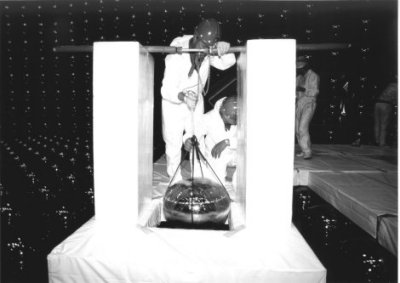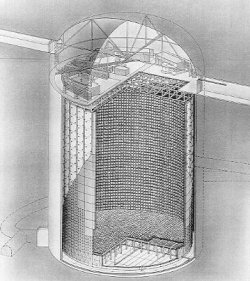 |
|
Totsuka:"We Will Rebuild the Detector" by Kurt Riesselmann

The accident at the Kamioka Observatory, an underground laboratory in Kamioka, Japan dedicated to neutrino research, devastated more than half of the 11,146 photomultiplier tubes inside the cylindrical, 41-meter high Super-Kamiokande chamber. The destruction presents a major setback in unraveling the secrets of a ghost-like particle called the neutrino. The Super-Kamiokande collaboration, consisting of scientists from Japan and the U.S., made worldwide news when it announced evidence for neutrino mass in 1998. “Super-K is the flagship of neutrino physics in the world,” said Janet Conrad, a neutrino expert at Columbia University. “While there is a fleet of other neutrino experiments, this is the leading one.” Technicians had emptied the tank for cleaning and had replaced a few hundred photomultiplier tubes (PMT), each 22 inches in diameter. They were in the process of refilling the tank with 50,000 tons (13 million gallons) of purified water. The water level had reached the 41st of 51 rows of PMTs when almost all the tubes in the submerged rows—except for five rows directly below the surface—imploded, researchers at the facility told a newspaper. “People in the nearby control room heard the terrible sound of the PMTs imploding clearly,” said Jeffrey Wilkes, cospokesperson for the U.S. K2K collaboration. “About seven thousand PMTs were destroyed.” Conrad, who is cospokesperson for the new MiniBooNE neutrino experiment at Fermilab, linked the apparent chain reaction inside the Super-K tank to the large amount of energy released when a PMT surrounded by high-pressure water implodes. Once the exterior of a PMT collapses, water rushes in to fill the vacuum inside the tube. As streams of high-speed water collide, a powerful shockwave leaves the PMT, perhaps capable of turning debris into high-speed projectiles that can destroy adjacent tubes, causing a chain reaction. A Super-K scientist, familiar with underwater video footage taken after the incident, reported that the “storm” inside the tank had twisted metal components of the tubes and ripped chunks of plastic out of thick plates. The steel support structure, however, appeared largely unaffected and sound.
At a press conference, Japan’s Science Minister Atsuko Tohyama said, “we would like to do all we can do to make it possible for the research to be conducted as before the incident.” Tohyama, who heads the Japanese agency funding the experiment, made it clear that the government would fully support financially the reconstruction of Super-Kamiokande.
“We will rebuild the detector,” he said. “There is no question.” Totsuka outlined a preliminary plan of recovery. Within a year he plans to resume the K2K experi-ment that, since 1999, has used the Super-K detector to study neutrino beams produced by accelerators at the KEK laboratory, 250 km east of Kamioka. To accomplish this goal, scientists would spread out the still functional PMTs and add 1,500 new ones to obtain a 20 percent coverage of the detector walls, half of the original capability. “This is sufficient for experiments detecting high-energy neutrinos produced by powerful accelerators, like the K2K experiment,” said Conrad. “To get good results for atmospheric and solar neutrinos you need more. There are lots of open questions that Super-K was working on.” According to Totsuka, it may take three years to refurbish the whole Super-K detector. John Beacom, a Fermilab theorist specializing in neutrino physics research, emphasized the need to regain the capabilities of the K2K experiment. “K2K was beginning to provide a first direct test of the atmospheric neutrino oscillation result obtained by Super-K,” he said. “It is extremely important that they rebuild.” Only a few months ago, on July 10, the K2K collaboration had announced their first significant results on neutrino oscillations involving a man-made neutrino beam. Over a two-year period scientists recorded 44 muon neutrinos from the KEK accelerator compared to an expected number of 64. Physicists attributed the discrepancy between these numbers to neutrino oscillations, the transformation of some muon neutrinos into other types of neutrinos that cannot be detected by the Super-K detector. The existence of neutrino oscillations implies that neutrinos must have mass. “As an experimental particle physics laboratory, Fermilab shares the pain at this great loss for our field,” said Mike Shaevitz, associate director at Fermilab. “Super-K led the way to a new level of understanding. We offer our solidarity at this difficult moment and our hope and encouragement for the soonest possible recovery from this terrible setback.”
On the web:
K2K News http://neutrino.kek.jp
|
| last modified 11/26/2001 email Fermilab |
FRLsDFx9eyfrPXgV
 Yoji Totsuka, director of the Kamioka Observatory, expressed his deep regrets to the Japanese, U.S. and Korean people who have generously supported the Super-Kamiokande experiment. But he showed confidence in the future of the experiment.
Yoji Totsuka, director of the Kamioka Observatory, expressed his deep regrets to the Japanese, U.S. and Korean people who have generously supported the Super-Kamiokande experiment. But he showed confidence in the future of the experiment.